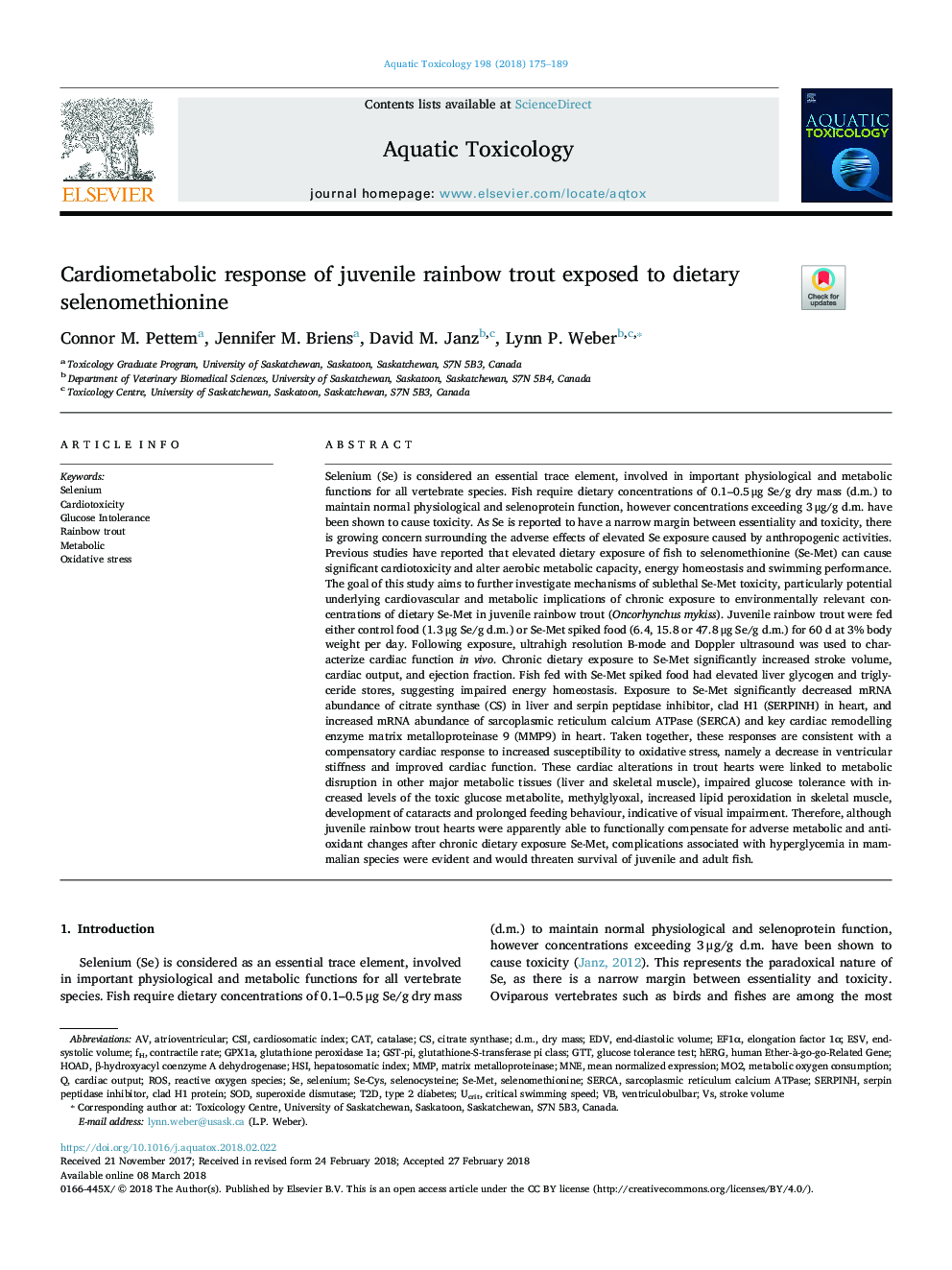| کد مقاله | کد نشریه | سال انتشار | مقاله انگلیسی | نسخه تمام متن |
|---|---|---|---|---|
| 8883791 | 1625907 | 2018 | 15 صفحه PDF | دانلود رایگان |
عنوان انگلیسی مقاله ISI
Cardiometabolic response of juvenile rainbow trout exposed to dietary selenomethionine
ترجمه فارسی عنوان
پاسخ قدیوماتوبولیک ماهی قزل آلای رنگین کمان نوجوان در معرض سلنمتینیون رژیم غذایی
دانلود مقاله + سفارش ترجمه
دانلود مقاله ISI انگلیسی
رایگان برای ایرانیان
کلمات کلیدی
MO2HOADSe-Metd.m.sarcoplasmic reticulum calcium ATPaseUcritEDVGST-piT2DHERGGTTCSIHSIMNEMMPESVCATEF1α - EF1aROS - ROSCardiac output - برون ده قلبیglucose tolerance test - تست تحمل گلوکزOxidative stress - تنش اکسیداتیوdry mass - جرم خشکEnd-diastolic volume - حجم انتهای دیاستولیکend-systolic volume - حجم سیستول پایینstroke volume - حجم ضربه ایAtrioventricular - دهلیزی ـ بطنیType 2 diabetes - دیابت نوع 2SOD - سدCritical swimming speed - سرعت شناور انتقادیSelenomethionine - سلنمتینیونSelenocysteine - سلنوسیستینSelenium - سلنیومCardiotoxicity - سمیت قلبیSuperoxide dismutase - سوکسوکس دیسموتازCitrate synthase - سیترات سیتواستاتHepatosomatic index - شاخص Hepatosomaticelongation factor 1α - ضریب انحنای 1αGlucose intolerance - عدم تحمل گلوکزRainbow trout - قزل آلای رنگین کمانSERCA - قلبmatrix metalloproteinase - ماتریکس متالوپروتئینازMetabolic - متابولیکhuman ether-à-go-go-related gene - ژن وابسته به اتر-أ-go-go انسان استCatalase - کاتالازReactive oxygen species - گونههای فعال اکسیژن
موضوعات مرتبط
علوم زیستی و بیوفناوری
علوم کشاورزی و بیولوژیک
علوم آبزیان
چکیده انگلیسی
Selenium (Se) is considered an essential trace element, involved in important physiological and metabolic functions for all vertebrate species. Fish require dietary concentrations of 0.1-0.5â¯Î¼g Se/g dry mass (d.m.) to maintain normal physiological and selenoprotein function, however concentrations exceeding 3â¯Î¼g/g d.m. have been shown to cause toxicity. As Se is reported to have a narrow margin between essentiality and toxicity, there is growing concern surrounding the adverse effects of elevated Se exposure caused by anthropogenic activities. Previous studies have reported that elevated dietary exposure of fish to selenomethionine (Se-Met) can cause significant cardiotoxicity and alter aerobic metabolic capacity, energy homeostasis and swimming performance. The goal of this study aims to further investigate mechanisms of sublethal Se-Met toxicity, particularly potential underlying cardiovascular and metabolic implications of chronic exposure to environmentally relevant concentrations of dietary Se-Met in juvenile rainbow trout (Oncorhynchus mykiss). Juvenile rainbow trout were fed either control food (1.3â¯Î¼g Se/g d.m.) or Se-Met spiked food (6.4, 15.8 or 47.8â¯Î¼g Se/g d.m.) for 60 d at 3% body weight per day. Following exposure, ultrahigh resolution B-mode and Doppler ultrasound was used to characterize cardiac function in vivo. Chronic dietary exposure to Se-Met significantly increased stroke volume, cardiac output, and ejection fraction. Fish fed with Se-Met spiked food had elevated liver glycogen and triglyceride stores, suggesting impaired energy homeostasis. Exposure to Se-Met significantly decreased mRNA abundance of citrate synthase (CS) in liver and serpin peptidase inhibitor, clad H1 (SERPINH) in heart, and increased mRNA abundance of sarcoplasmic reticulum calcium ATPase (SERCA) and key cardiac remodelling enzyme matrix metalloproteinase 9 (MMP9) in heart. Taken together, these responses are consistent with a compensatory cardiac response to increased susceptibility to oxidative stress, namely a decrease in ventricular stiffness and improved cardiac function. These cardiac alterations in trout hearts were linked to metabolic disruption in other major metabolic tissues (liver and skeletal muscle), impaired glucose tolerance with increased levels of the toxic glucose metabolite, methylglyoxal, increased lipid peroxidation in skeletal muscle, development of cataracts and prolonged feeding behaviour, indicative of visual impairment. Therefore, although juvenile rainbow trout hearts were apparently able to functionally compensate for adverse metabolic and anti-oxidant changes after chronic dietary exposure Se-Met, complications associated with hyperglycemia in mammalian species were evident and would threaten survival of juvenile and adult fish.
ناشر
Database: Elsevier - ScienceDirect (ساینس دایرکت)
Journal: Aquatic Toxicology - Volume 198, May 2018, Pages 175-189
Journal: Aquatic Toxicology - Volume 198, May 2018, Pages 175-189
نویسندگان
Connor M. Pettem, Jennifer M. Briens, David M. Janz, Lynn P. Weber,
